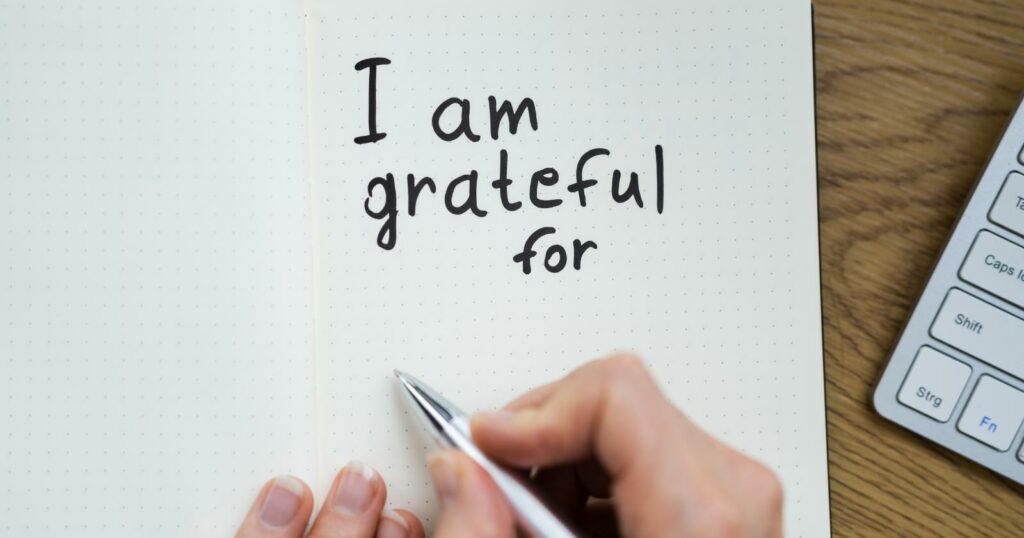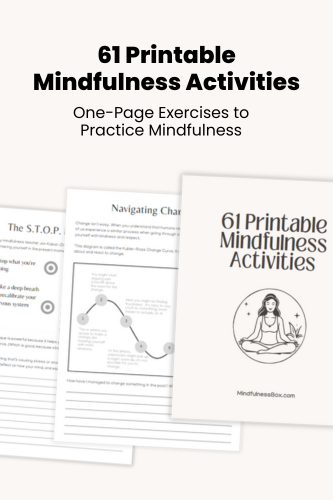Meetings can be chaotic, but using grounding exercises for meetings can invite a sense of calm and relaxation for participants. Whether you’re running a meeting or conducting a seminar, group grounding exercises can start your session off on the right foot—or reset a group’s energy in the middle of long meetings.
A Mini-Guide to Grounding Exercises for Groups
Using a grounding activity for meetings is a great way to create deeper connections and more mindful sessions, and bring greater intention to your interactions.
Here’s how to think about group grounding exercises:
First, check in with the energy you’re bringing into the meeting. Any to-do lists you have or emotional baggage you’re carrying, let it go for the duration of the meeting.
Second, show compassion to other participants in the meeting by checking in with them. How are they doing? If they seem stressed or agitated, keep in mind that you don’t know what they’re going through.
Third, breathe. Remember to keep your nervous system balanced with deep breaths. As needed, take short breaks to do an emotional reset by turning off your camera and microphone.
From setting an intention for your session, to incorporating a “mindful minute” into a meeting, to running entire sessions based around mindfulness, the following tips will help ground your meetings and create a more mindful, “in the moment” environment.
Get dozens of one-page exercises to help practice mindfulness, meditation, gratitude, and self love. Perfect for printable handouts when teaching mindfulness to groups, students, or in the workplace.
To see examples, plus a full list of the 61 exercises included, click below.
1) Create an intention for your session
Every meeting requires a clear purpose and desired outcome. However, setting intentions delves deeper, fostering personal and collective mindfulness. Encourage your participants to reflect on and identify their individual intentions for the session.
For instance, a participant might think, “My intention is to embrace joy today and remain grounded in every moment.”
To further enhance the group experience, consider guiding the participants by establishing a collective intention for the entire session. This unifying intention could be something like, “Our shared intention is to cultivate a sense of presence, attentiveness, and compassion during our time together.”
By setting both personal and group intentions, participants can foster a deeper sense of connection and purpose throughout the session, leading to more meaningful and focused interactions.
2) Incorporate movement and body awareness
Breaking up meetings with movement can be particularly beneficial when participants spend extended periods sitting.
This can be especially powerful if you need grounding exercises for Zoom meetings, since your participants will have been at their computer for quite some time.
Encourage your attendees to stand up and take a moment to deeply inhale and exhale, focusing on their physical sensations and becoming more in tune with their bodies.
Prompt them to pay attention to any feelings or sensations they experience, whether positive or negative, and simply observe without judgment. This mindful awareness of their bodily state can help participants feel more grounded and present.
Finally, as they continue to stand and breathe, invite them to perform a mental “reset” by considering the intention they’d like to carry forward for the remainder of the session. This brief interlude of movement and intention-setting can reinvigorate participants, enhancing their focus and engagement as the session continues.
3) Experience the calming effects of finger tapping
Finger tapping is a simple yet effective grounding technique that promotes relaxation and bodily awareness. Because of its interactive nature, it’s also a great option for short grounding exercises for groups.
Here’s how to do the finger tapping exercise:
- Bring your index finger and thumb together, forming a gentle touch between the fingertips.
- Inhale deeply, filling your lungs with air, and then slowly exhale, releasing any tension or stress.
- Repeat this process with your middle finger, ring finger, and pinky finger, allowing each fingertip to meet your thumb in turn.
- After reaching the pinky finger, reverse the sequence by tapping your ring finger, middle finger, and index finger to your thumb once more.
- Continue to cycle through this pattern, synchronizing each fingertip connection with a deep, calming breath.
Finger tapping serves as a grounding exercise that helps regulate your breathing, soothe your nervous system, and foster a deeper connection with your body. By incorporating this practice into your mindfulness routine, you can cultivate a greater sense of inner tranquility and presence.
4) Embrace yawning and stretching

The yawn and stretch technique is particularly effective during morning meetings or sessions with younger participants, serving as both an icebreaker and a mindfulness exercise. By acknowledging the early hour and the common feeling of sleepiness, you create a relatable and shared experience among attendees.
Yawning and stretching not only helps to wake up the body but also heightens self-awareness. As you engage in this exercise, encourage participants to notice and release any areas of tension they may be holding.
Here’s how to practice the yawn and stretch technique:
- Invite participants to take a deep, deliberate yawn, fully opening their mouths and inhaling deeply.
- As they exhale, encourage them to slowly stretch their arms and upper body, reaching towards the sky or extending outward.
- Guide them to focus on the sensations in their bodies, paying attention to any tightness or discomfort and gently releasing it as they stretch.
- Encourage participants to yawn and stretch for about 20-30 seconds, taking their time to fully experience the rejuvenating effects.
By incorporating the yawn and stretch technique into your session, you can help participants reconnect with their bodies, release tension, and create a more relaxed and alert state of mind. This simple exercise can lead to increased focus and engagement throughout the session.
5) Let go of distractions
It’s natural for participants to carry various forms of mental clutter into your session, such as feelings of tardiness, recent disagreements, hectic mornings, or looming to-do lists. Acknowledging and releasing these distractions can help create a more focused and mindful atmosphere.
Guiding a group to let go of distractions:
- Invite participants to take a moment to recognize any thoughts or emotions they’re currently holding onto that might distract them during the session.
- Encourage them to mentally list these distractions, acknowledging their presence without judgment or criticism.
- Suggest that they visualize placing each distraction in a box or a bubble, gently separating these concerns from their immediate experience.
- Guide them to take a few deep breaths, granting themselves permission to release these distractions for the duration of the session, and to fully immerse themselves in the present moment.
- Assure them that they can return to these thoughts or emotions after the session, but for now, their focus is on the current experience.
By fostering an environment of non-judgmental awareness and encouraging participants to let go of their distractions, you can create a more mindful and attentive atmosphere.
This intentional release allows attendees to fully engage with the session, benefiting from the shared experience and deepening their connection to the present moment.
6) Practice mindful listening

Invite your participants to engage in a mindful listening exercise that brings their attention to the present moment and heightens their awareness of their surroundings.
Mindful music listening step-by-step guide:
- Ask participants to gently remove their earbuds or headphones, creating a direct connection with the sounds around them.
- Encourage them to close their eyes or soften their gaze, allowing them to fully concentrate on their sense of hearing.
- Prompt them to take a few deep breaths, relaxing their bodies and minds as they prepare to listen attentively.
- Invite them to focus on the various sounds they can hear in their immediate environment, whether it’s traffic, birdsong, or the voices and movements of people or animals nearby.
- Encourage them to give their full attention to the soundscape, observing the different layers of sound without judgment or analysis.
- After a minute or two, guide them to gradually return their focus to the session, acknowledging the heightened awareness they’ve cultivated through this exercise.
By practicing mindful listening, participants can become more attuned to the present moment and their surroundings. This simple yet powerful exercise helps to cultivate a deeper connection with the world around them, fostering a sense of presence and grounding that can enhance their overall experience during the session.
7) Create calm with belly breathing
Guide your participants through a deep belly breathing exercise, promoting relaxation and mindfulness. This practice helps to reduce stress, increase focus, and enhance overall well-being.
Belly breathing step-by-step guide:
- Invite participants to find a comfortable seated position with a straight but relaxed posture, placing one hand on their chest and the other on their belly.
- Instruct them to take a deep, slow breath through their nose for five seconds, allowing the air to fill their abdomen, making the hand on their belly rise while the one on their chest remains relatively still.
- Once they’ve reached the peak of their inhalation, ask them to hold their breath for five seconds, maintaining a sense of calm and relaxation.
- Guide them to slowly exhale through their mouth for five seconds, feeling the hand on their belly lower as the air leaves their body.
- After completing the exhale, encourage them to pause and hold their breath for another five seconds before beginning the cycle anew.
- Lead participants through several rounds of this breathing pattern, allowing them to fully immerse themselves in the calming rhythm of their breath.
Belly breathing is a powerful relaxation technique that helps to regulate the nervous system and foster a deeper connection with the body. By incorporating this practice into your session, you can create a more mindful and focused atmosphere for participants to engage with and benefit from.
8) Engage your senses
Engaging your senses is a good option if you’re cultivating fun grounding activities for meetings, and it’s especially effective for remote meetings because it adds a sensory presence to the virtual interaction.
Here are some ideas to help you engage the senses of your participants:
- Savor Your Drink: Invite attendees to mindfully savor their drink, whether it’s water, tea, coffee, or soda. Encourage them to take a sip and hold the liquid in their mouth for a moment before swallowing. Guide them to pay attention to the temperature, taste, and sensation of the liquid as it enters their body. Focusing on these details helps create a more mindful and present experience.
- Explore Touch: For younger participants or those looking for a tactile experience, ask them to find a favorite toy or any nearby object. Instruct them to focus on the sensation of touch as they slowly run their hand or fingers across the surface of the object. Encourage them to experiment with different textures, using their fingernails or varying pressure, to heighten their awareness of touch.
- Raisin Mindfulness Exercise: This activity is suitable for both children and adults and engages the full spectrum of senses. Provide advance notice for participants to have a raisin or any small, edible item on hand. Guide them through the process of mindfully observing the raisin’s appearance, texture, smell, and taste as they slowly and deliberately eat it. This exercise fosters greater mindfulness by encouraging participants to fully experience each sensory aspect of the raisin.
Incorporating sensory experiences into your session can help participants connect more deeply with the present moment and cultivate a greater sense of mindfulness. By engaging their senses, they can better focus on the session’s content and derive more value from the experience.
9) Feel the ground beneath your feet
Encourage participants to engage in a barefoot mindfulness exercise, allowing them to focus on sensations they might not usually notice.
Ask them to remove their shoes and socks, and walk around on different surfaces like carpet, wood, or tile. Guide them to observe the sensations beneath their feet and compare the textures and temperatures of various surfaces.
You can also incorporate a walking meditation session, using a guided meditation to enhance the experience.
10) Embrace self-compassion
Many people grapple with self-compassion, often being overly critical of themselves or holding unrealistic expectations. Encourage participants to let go of any self-judgment and foster a mindset of self-compassion. Reassure them that taking the time to show up and invest in their personal growth is already a significant accomplishment that they should be proud of.
Remind participants that progress in any practice takes time, patience, and persistence. It’s essential to acknowledge and celebrate the small victories along the way, rather than focusing solely on perceived shortcomings. By embracing self-compassion, individuals can cultivate a more positive, empowering attitude toward their personal journey and growth.
Offer tips and techniques to help participants develop self-compassion, such as:
- Mindful self-awareness: Encourage them to observe their thoughts and feelings without judgment, acknowledging their emotions and experiences as valid.
- Kind self-talk: Suggest they practice speaking to themselves with the same kindness, understanding, and encouragement they would offer to a friend in a similar situation.
- Forgiveness: Remind participants that everyone makes mistakes, and it’s essential to forgive ourselves and learn from these experiences instead of dwelling on them.
By nurturing self-compassion, participants can build a healthier relationship with themselves, which contributes to greater resilience, well-being, and personal growth.
11) Take time for gratitude

As the session comes to an end and participants prepare to continue their day, encourage them to reflect on three things they’re grateful for.
These can be experiences from the session or other aspects of their lives. Fostering a sense of gratitude helps promote positivity and reinforces the benefits of their mindfulness practice.
By consciously cultivating gratitude, participants can carry the positive energy from the session into the rest of their day.
Embracing grounding exercises for meetings
Centering exercises for meetings are a way to create intimacy among participants and recapture a human element that’s often lost in the busy-ness of meetings and group sessions.
As you digest the information above, consider these essential takeaways:
- Establish a strong foundation for your mindfulness session by setting an intention for yourself and your participants. Encourage participants to recognize their energy levels and release any distractions to fully immerse themselves in the practice.
- Adapt numerous mindfulness activities to fit your group, ranging from breathing exercises and finger tapping to meditation. To maintain engagement, intersperse longer stretches with interactive activities that encourage movement and physical participation.
- Conclude your session by fostering positive energy among your participants. Focus on self-compassion, loving-kindness, and gratitude to help them transition into their day feeling refreshed and inspired.
By following these points, you can create an effective grounding experience that brings tranquility to participants and allows them to connect on a new level.

My mindfulness practice kicked off in 2016 with a ten-day silent retreat. Since then, I’ve read dozens of books about mindfulness and completed hundreds of hours of meditation. Thinking about what makes humans happy, calm, and peaceful is endlessly fascinating to me.


